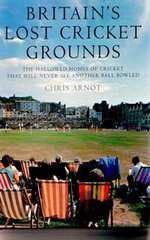Britain’s Lost Cricket Grounds
David Taylor |Published: 2011
Pages: 192
Author: Arnot, Chris
Publisher: Aurum Press
Rating: 4 stars

Nostalgia, as the joke goes, isn’t what it used to be. Yet there seems be a ready market for the type of book aimed at the more mature cricket fan, one who is far more concerned at how his (and it nearly always is “his”) county is doing in the Championship than which IPL franchise Kevin Pietersen will sign for this year. I suppose as one gets older and the world changes in ever more bewildering ways, it is easy to wrap oneself up in the fug of nostalgia, which is why I like to spend much of my free time listening to barely-remembered songs from the sixties and seventies – the aural equivalent of “comfort eating”. This clinging on to the past, whatever you might call it, is a feeling present throughout Chris Arnot’s book. Indeed, in his introduction he reassures the reader “don’t worry, we won’t be dwelling too long in the present.” Here he outlines some of the reasons – generally financial inducements – for clubs moving out of the grounds featured in this book and allowing them to be turned into shopping centres, housing estates and the like. 38 grounds, most of them previously unknown to me, are included – in no obvious order, including a couple apiece in Wales and Scotland.
I know nothing of the author apart from what I read on the dust jacket – he is a journalist who has written for a number of broadsheet newspapers, and he makes a couple of references to himself in the text, one which talks of spending his formative years at Edgbaston, the other of scoring a hundred at Llanillar, near Aberystwyth. I was under the impression when I first looked at the book that all the grounds were used for county cricket – that is not actually the case, although as at Llanillar the county sometimes came to play a friendly or benefit game – while Staveley in the Lake District played in the Westmorland League, and I don’t think even Westmorland exists any more. I am not sure why these particular grounds were chosen, as not all of them could have been called picturesque. If we’re talking of county cricket venues no longer used, Kent alone used to play at Dartford, Gillingham, Gravesend, Blackheath, Dover, Folkestone, Maidstone and Tonbridge. Only the last-named is to be found here. It could be that in the other cases the grounds are still in existence and so the county could, in theory, return there some day. Tonbridge’s cricket ground is now a car park and selection of shops and so, to borrow the subtitle from the cover, will never see another ball bowled.
From time to time former players turn up – for instance Derek Underwood talks about his success at Hastings, where he made his only hundred in a memorable game that ended in a tie (and which gets no fewer than ten pictures in a book packed with illustrations) while Robin Hobbs, the last English leg-spinner, as we’re reminded, to take a thousand first-class wickets, talks about an early game he played at the Hoffmann ground at Chelmsford, one of many bearing the name of a local business. Many of the players pictured though, from Lord Hawke to WG Grace, have themselves long been consigned to cricket history.
To call this a “coffee table book” detracts from the quality of the text, although it is beautifully produced and lavishly illustrated. Its tone is wistful without being too mournful, even if the caption for the Co-Operative’s ground at New Eltham “since burned down by vandals” is singularly depressing. Arnot concludes his introduction with the expectation “that no shopping centres will be built on Broadhalfpenny Down in Hambledon.” I wouldn’t stake my house on it, to be honest, but we can hope he is to be proved right – and for all the grounds that weren’t so fortunate, there is this lovely memorial.






All the grounds featured in this book are no longer there. Some of them were not first class grounds. In some cases e.g. Hastings, the clubs sold the ground and used the money to build another one.
Chris Arnot has also brought out another book called Britain’s Lost Cricket Festivals covering grounds that used to hold first class cricket festival weeks. Some of these grounds are still there and used for club cricket.
Comment by Colin Price | 4:43pm GMT 28 February 2018